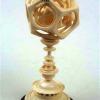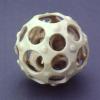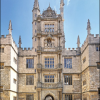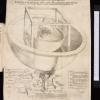Mathematical model (from 1620)
Commentary
MATHEMATICAL MODEL, 1620
Description. Material(s): Alabaster, wood, brass. Dimensions: H 760 mm, W 450 mm, D 450 mm. Provenance: Originally given to the Bodleian Library by Sir Clement Edmondes in 1620. Lent to the Museum of the History of Science in 1952: Inventory No. 90861.
Origin. In 1620 Henry Savile began the lectures that inaugurated his new Oxford professorships of geometry and astronomy. The professors were based in the Bodleian Library's Tower of the Five Orders. In the same year Sir Clement Edmondes (1564?-1622), a diplomat and municipal official of London who was also Clerk of the Council and Fellow of All Souls, donated this 'mathematical model' to the library. Von Uffenbach’s account reveals that it was displayed in the Bodleian along with the armillary sphere and quadrant; but its precise symbolic meaning and pedagogical purpose remain unclear.
Commentary. The alabaster sculpture combines geometry and architecture. Each side of the central column contains a rusticated version of one of the five architectural orders, with the fragmentary remains of the five Euclidean regular solids around the base. The whole is surmounted by a large dodecahedron, to which Plato had ascribed cosmological significance as reflecting the structure of the heavens. The model acts as a sort of symbolic and pedagogical machine, with the correspondence between the five geometrical solids and the five architectural orders providing part of the work's basic conceit.
Further reading: Alexander Marr, '"Curious and Useful Buildings”: The Mathematical Model of Sir Clement Edmondes', Bodleian Library Record, vol. 18, no. 2 (2004), pp. 108-50.





